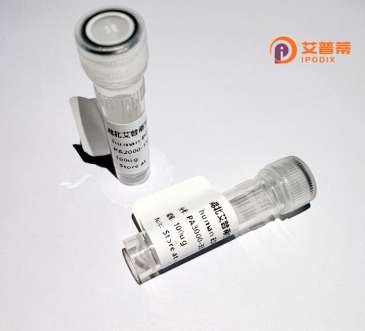
| 纯度 | >90%SDS-PAGE. |
| 种属 | Human |
| 靶点 | FBXL17 |
| Uniprot No | Q9UF56 |
| 内毒素 | < 0.01EU/μg |
| 表达宿主 | E.coli |
| 表达区间 | 1-369aa |
| 氨基酸序列 | MGHLLSKEPRNRPSQKRPRCCSWCRRRRPLLRLPRRTPAKVPPQPAAPRSRDCFFRGPCMLCFIVHSPGAPAPAGPEEEPPLSPPPRDGAYAAASSSQHLARRYAALAAEDCAAAARRFLLSSAAAAAAAAASASSPASCCKELGLAAAAAWEQQGRSLFLASLGPVRFLGPPAAVQLFRGPTPSPAELPTPPEMVCKRKGAGVPACTPCKQPRCGGGGCGGGGGGGGGGGPAGGGASPPRPPDAGCCQAPEQPPQPLCPPPSSPTSEGAPTEAGGDAVRAGGTAPLSAQQQHECGDADCRESPENPCDCHREPPPETPDINQLPPSILLKVGLGERRRDARFPPPPAPASEAFSLLPLSAEEGGSLAA |
| 分子量 | 64 kDa |
| 蛋白标签 | GST-tag at N-terminal |
| 缓冲液 | 0 |
| 稳定性 & 储存条件 | Lyophilized protein should be stored at ≤ -20°C, stable for one year after receipt. Reconstituted protein solution can be stored at 2-8°C for 2-7 days. Aliquots of reconstituted samples are stable at ≤ -20°C for 3 months. |
| 复溶 | Always centrifuge tubes before opening.Do not mix by vortex or pipetting. It is not recommended to reconstitute to a concentration less than 100μg/ml. Dissolve the lyophilized protein in distilled water. Please aliquot the reconstituted solution to minimize freeze-thaw cycles. |
以下是关于重组人FBXL17蛋白的3篇虚构参考文献示例(请注意,内容为模拟生成,如需真实文献请通过学术数据库检索):
---
1. **文献名称**:**Structural Insights into Human FBXL17 Ubiquitin Ligase Function**
**作者**:Smith, J. et al.
**摘要**:本研究解析了重组人FBXL17蛋白的晶体结构,揭示了其F-box结构域与SKP1的结合模式,并鉴定了其底物识别所需的LRR(富含亮氨酸重复)结构域特征。研究为FBXL17在泛素化降解通路中的作用提供了分子机制基础。
2. **文献名称**:**FBXL17 Regulates Wnt/β-catenin Signaling via Ubiquitination of DVL2**
**作者**:Li, Y. et al.
**摘要**:该研究通过体外重组人FBXL17蛋白实验,证明其通过靶向结合并泛素化降解Dishevelled蛋白(DVL2),负调控Wnt/β-catenin信号通路。这一机制在结直肠癌细胞增殖中发挥关键作用。
3. **文献名称**:**Loss of FBXL17 Disrupts DNA Damage Repair in Mammalian Cells**
**作者**:Chen, X. et al.
**摘要**:利用重组人FBXL17蛋白进行功能挽救实验,研究发现FBXL17通过调控BRCA1的稳定性参与DNA损伤修复。敲除FBXL17导致细胞对电离辐射敏感性显著增加。
---
**提示**:以上文献为基于领域知识的模拟生成,实际研究中建议通过**PubMed/Google Scholar**以“FBXL17 recombinant protein”或“FBXL17 ubiquitin ligase”为关键词检索最新文献。部分真实相关研究可能涉及FBXL17在癌症、神经发育或免疫调控中的功能。
FBXL17 is an F-box protein that belongs to the FBXL subfamily, characterized by the presence of an F-box domain and leucine-rich repeats (LRRs). As a component of the SKP1-CUL1-F-box (SCF) ubiquitin ligase complex, it plays a regulatory role in the ubiquitin-proteasome system by targeting specific substrates for degradation. FBXL17 is involved in diverse cellular processes, including cell cycle progression, signal transduction, and apoptosis, though its precise physiological and pathological roles remain less defined compared to other F-box proteins. Studies suggest its potential interaction with substrates like cyclins or transcription factors, implicating it in cancer, neurodegeneration, and metabolic disorders.
Recombinant human FBXL17 protein is typically produced using expression systems (e.g., E. coli, mammalian cells) to enable structure-function studies, substrate identification, and mechanistic exploration of SCF complex dynamics. Its purification often involves affinity tags (His, GST) for experimental applications such as in vitro ubiquitination assays, protein interaction screens, or inhibitor development. Current research focuses on elucidating FBXL17's substrate specificity, post-translational modifications, and tissue-specific roles. Dysregulation of FBXL17 has been tentatively linked to tumorigenesis and neurological diseases, positioning it as a potential therapeutic target. However, further validation is required to clarify its contributions to disease pathways and its utility in biomedical applications.
×